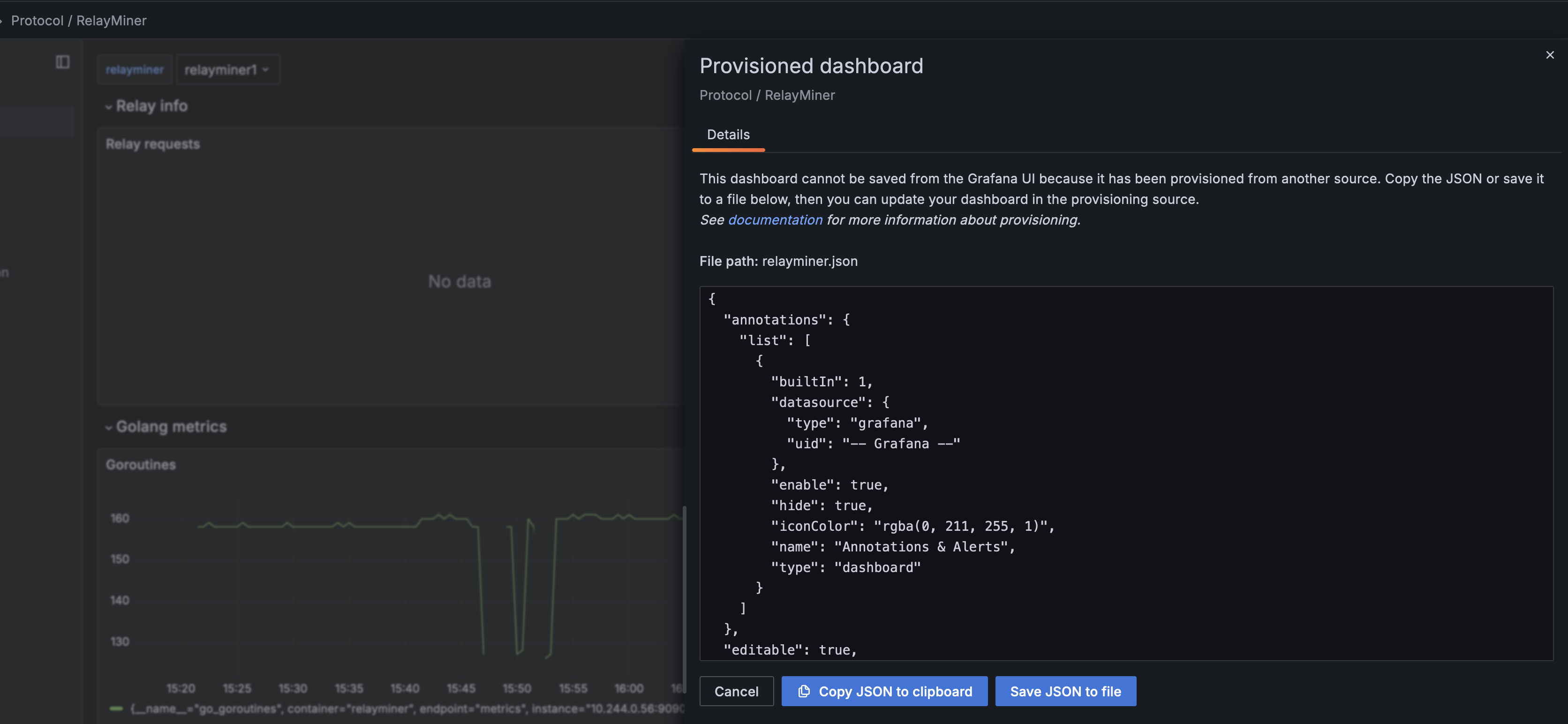LocalNet
Background
This document walks you through launching a LocalNet that brings up a k8s cluster with a Data Availability network, a validator, Pocket actors and everything else needed to send an end-to-end relay.
- Run Poktroll locally
- Developing with LocalNet
- Observability
- High-level overview of LocalNet
- Troubleshooting
Run Poktroll locally
Report issues
If you encounter any problems, please create a new GitHub Issue here.
TL;DR
- Install dependencies:
- Run
make localnet_upto start the network - When prompted, click
spaceto see the web UI with logs and current status of the network. Alternatively, you can go directly to localhost:10350
Developing with LocalNet
localnet_config.yaml
Once LocalNet is started, a new file localnet_config.yaml is generated in the root directory of the repository. This file contains the configuration of the network. It looks like this:
helm_chart_local_repo:
enabled: false
path: ../helm-charts
relayers:
count: 1
Scaling network actors
To scale the number of actors, edit the localnet_config.yaml file and change the count of the relayers.
For example:
helm_chart_local_repo:
enabled: false
path: ../helm-charts
relayers:
- count: 1
+ count: 2
NOTE: You may need to up to 1 minute for the new actors to be registered and deployed locally.
Offchain actors configuration
We heavily use Helm charts for configuring LocalNet. The goal is to maximize the tooling involved in deploying production workloads and local development.
Following best practices in Helm chart design, we have default values defined in the values.yaml file of each service
Helm chart. For example, here are the RelayMiner values.yaml.
Local infrastructure requires some changes to the default values to properly configure the RelayMiner
or PATH Gateway, so we override some of the values. You can find such overrides in the
poktroll/localnet/kubernetes directory.
IF YOU NEED TO CHANGE LocalNet configs, 👆 is the place.
Modify Kubernetes workloads
The local cluster is dependant on the latest available helm charts available at github.com/pokt-network/helm-charts.
If you need to modify Kubernetes resources in your local setup, follow these steps.
Clone the helm charts locally:
cd .. && git clone git@github.com:pokt-network/helm-charts.git
cd -
Update the path of the helm charts to the relative path of the cloned repository:
sed -i'' -e '/helm_chart_local_repo:/,/path:/ s|\(path: \).*|\1../helm-charts|' localnet_config.yaml
Set the helm_chart_local_repo.enabled flag in localnet_config.yaml to true:
sed -i'' -e '/helm_chart_local_repo:/,+1 s/\(enabled: \)true/\1false/; /helm_chart_local_repo:/,+1 s/\(enabled: \)false/\1true/' localnet_config.yaml
You can always set it back to false with:
sed -i'' -e '/helm_chart_local_repo:/,+1 s/\(enabled: \)false/\1true/; /helm_chart_local_repo:/,+1 s/\(enabled: \)true/\1false/' localnet_config.yaml
Observability
You can configure LocalNet to deploy third-party observability tools such as Prometheus and Grafana:
localnet_config.yaml:
observability:
enabled: true
Access dashboards with graphs and logs
Each service in Tilt has a link to its own Grafana dashboard as seen in the image below.
Specifically, the RelayMiner, Validator, PATH Gateway and others each have a separate dashboards.

How to update and save an existing dashboard?
Every time LocalNet is re-started, Grafana is deployed and provisioned from scratch.
A list of existing dashboards are saved as JSON files in localnet/grafana-dashboards.
If you wish to change a dashboard, do the following:
- Make the necessary modifications in the Grafana UI
- Click save button. This will then display the updated JSON output of the dashboard
- Copy-paste the output to the corresponding file in
localnet/grafana-dashboards

High-level overview of LocalNet
This section describes how LocalNet operates and the interactions between different components to provision a working network.
LocalNet Deployment Flow
After you execute make localnet_up, many things happen:
igniteCLI provisions a newgenesis.jsonand validator keys.tiltstarts and runs a Tiltfile - a Python-like script.- Subsequently, the logic described in the
Tiltfileexecutes various CLI commands, communicates with thek8sAPI, and creates or reads the LocalNet configuration file:- Creates a new
localnet_config.yamlif it doesn't exist. Updates it with default values if new ones are introduced. - Depending on the configuration in
localnet_config.yaml, uses Helm charts from the local helm-chartsrepository or downloads Helm charts from our Helm chart repository (https://pokt-network.github.io/helm-charts/). - Compiles the
poktrolldbinary from the source code. - Using values from
localnet_config.yaml, provisions an observability stack (Grafana, Prometheus, Loki), a validator, PATH Gateways, RelayMiners, etc.
- Creates a new
- With
make localnet_upcontinually running in the background,tiltmonitors for code changes and re-compiles the binary when a code change is detected. After the new binary is built, it is pushed to the containers and all processes restart.
Troubleshooting
Clean Slate (Nuclear Option)
If you're encountering weird issues and just need to start over, follow these steps:
make localnet_down
kind delete cluster
make docker_wipe
make go_develop_and_test
kind create cluster
make localnet_up